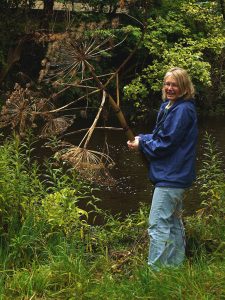New Teaching Tool, “A bioinformatics pipeline for exploring transcriptional regulation in plants”
We’re excited to announce the publication of The Plant Cell’s latest Teaching Tool, “A bioinformatics pipeline for exploring transcriptional regulation in plants,” by Amy Marshall-Colon, Mary Williams and Kranthi Varala, available without subscription at Plantae.org.
It is difficult to conceptualize genome-wide transcriptional regulation and even more challenging to organize, analyze, and visualize data at this scale. Network analysis of gene expression data is a popular way for plant scientists to deal with “-omic” scale data. However, the tools and techniques needed for such an analysis are not commonly taught alongside other plant biology curricula.
Here, we present a flexible learning module that provides students with training in the construction and analysis of a co-expression network in the context of transcriptional regulation by TFs. This module can be taught as a traditional lecture or as a hands-on module for small lecture or laboratory courses. The first part of the lesson provides background and theory for the analysis, and the second part provides two step-by-step tutorials for hands-on exploration of the tools used for transcriptional analysis.
Like all Teaching Tools, this article has undergone rigorous peer review, and includes a set of PowerPoint slides for use in teaching, a review article suitable for undergraduates, a teaching guide with questions to prompt students to synthesize the information presented, and a short, 24-slide abridged slide set. There are also two short videos that demonstrate some of the steps in the bioinformatics pipeline.
Three authors contributed to this Teaching Tool, providing their breadth of perspectives and expertise.
 Amy Marshall-Colon is an assistant professor in the Department of Plant Biology at the University of Illinois Urbana-Champaign. The focus of her research is to explore the regulatory mechanisms controlling nitrogen uptake and assimilation in plants using a systems biology approach. The overarching goal of her research is to use predictive network modeling to identify the most effective engineering strategies to improve crop productivity in response to environmental challenges imposed by global climate change. Specific research interests include dynamic network modeling to explore regulation of long-distance nitrogen signaling between roots and shoots; using multi-scale modeling to integrate new and legacy plant models across biological levels for more accurate prediction of plant response to environmental signals; and exploring molecular networks that underlie high- and low-quality legume-rhizobium mutualisms.
Amy Marshall-Colon is an assistant professor in the Department of Plant Biology at the University of Illinois Urbana-Champaign. The focus of her research is to explore the regulatory mechanisms controlling nitrogen uptake and assimilation in plants using a systems biology approach. The overarching goal of her research is to use predictive network modeling to identify the most effective engineering strategies to improve crop productivity in response to environmental challenges imposed by global climate change. Specific research interests include dynamic network modeling to explore regulation of long-distance nitrogen signaling between roots and shoots; using multi-scale modeling to integrate new and legacy plant models across biological levels for more accurate prediction of plant response to environmental signals; and exploring molecular networks that underlie high- and low-quality legume-rhizobium mutualisms.
Amy writes, “I’m passionate about empowering biologists to analyze and interpret the big data that they generate. But, computational biology can be intimidating for beginners. I designed this teaching tool around open-source, online tools with intuitive user interfaces to lower the barrier for entry-level computational biologists. My hope is that the tutorial makes transcriptome data analysis accessible to students and researchers wanting to take a more active role in data analysis.”
 Kranthi Varala is an Assistant Professor in the department of Horticulture and Landscape Architecture at Purdue University. His lab is focused on understanding the response of plants to external stresses and the regulation of these response mechanisms. This problem is approached at two scales: 1. The immediate response of individual plant species to changes in their environment on a scale of minutes to hours and 2. Long term adaptations in plant species to adjust to life in challenging environments, on a scale of thousands to millions of years. With this two-scale approach, his lab aims to identify the key players in plant response to their environment and how those responses have been shaped over and evolutionary scale to allow plants to survive in a wide range of ecological niches.
Kranthi Varala is an Assistant Professor in the department of Horticulture and Landscape Architecture at Purdue University. His lab is focused on understanding the response of plants to external stresses and the regulation of these response mechanisms. This problem is approached at two scales: 1. The immediate response of individual plant species to changes in their environment on a scale of minutes to hours and 2. Long term adaptations in plant species to adjust to life in challenging environments, on a scale of thousands to millions of years. With this two-scale approach, his lab aims to identify the key players in plant response to their environment and how those responses have been shaped over and evolutionary scale to allow plants to survive in a wide range of ecological niches.
Kranthi writes, “I love studying complex problems, and few problems are more complex than how an organism with tens of thousands of genes and thousands of regulators (called transcription factors) can sense and adapt to its environment. Computational biology, especially concepts from network theory and machine learning, are critical to develop a whole organism level understanding of how plants can thrive under extreme challenges. This tutorial was developed with the goal of encouraging students to start thinking about how advances in the computational and statistical fields can help study and understand biological phenomenon. “
 Mary Williams is a Features Editor of The Plant Cell and the developer and editor of the Teaching Tools in Plant Biology series. Mary enjoys making complex material accessible to students. As a plant scientist who has never played with large datasets, she was happy to play the role of an inexperienced student, the help Amy and Kranthi develop their tutorial to a level that would be accessible and interesting to students. “I was so proud when I was testing the prototype of the tutorial and I made my first gene expression heat map and network map. I’m a huge proponent of active learning and these activities should stimulate interest in these data analysis methods.”
Mary Williams is a Features Editor of The Plant Cell and the developer and editor of the Teaching Tools in Plant Biology series. Mary enjoys making complex material accessible to students. As a plant scientist who has never played with large datasets, she was happy to play the role of an inexperienced student, the help Amy and Kranthi develop their tutorial to a level that would be accessible and interesting to students. “I was so proud when I was testing the prototype of the tutorial and I made my first gene expression heat map and network map. I’m a huge proponent of active learning and these activities should stimulate interest in these data analysis methods.”
You can access these resources here.




